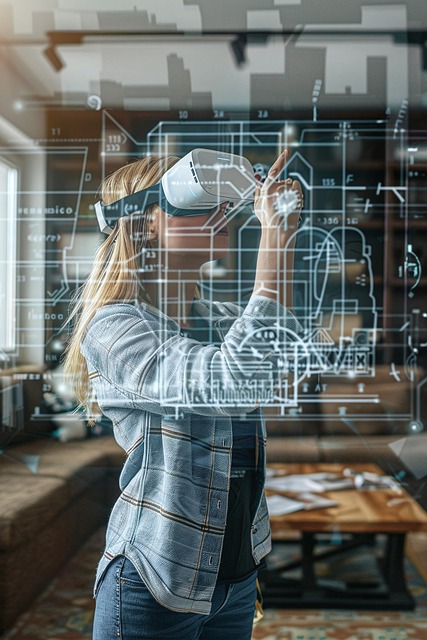Virtual interior design software empowers designers to manipulate lighting with precision, simulating natural and artificial light interactions for immersive visualizations. Through advanced rendering techniques and strategic light source placement, designers create digital interiors evoking moods from serene to vibrant, enhancing client presentations and fostering innovation in space experience. Customizable illumination effects allow for tailored lighting scenarios, dramatically altering ambiance from cozy reading nooks to dynamically lit entertainment areas.
Lighting plays a pivotal role in shaping the ambiance of indoor spaces, influencing our moods and perceptions. This article explores the art of lighting simulation, a powerful tool for enhancing interior design. We delve into the impact of mood lighting and its ability to transform environments, focusing on virtual interior design solutions. Through digital tools, designers can create realistic lighting scenarios, offering customizable effects that elevate any space, making it both inviting and aesthetically captivating.
Understanding Mood Lighting and Its Impact on Interiors
Mood lighting is a powerful tool in interior design, aiming to create an atmosphere and enhance the overall ambiance of a space. It involves strategically using artificial light sources to achieve specific effects, such as warmth, coziness, or drama. In virtual interior design, this concept becomes even more accessible and versatile. By employing advanced lighting simulation techniques, designers can experiment with various lighting scenarios without physical setup, allowing for a deeper understanding of how different lights impact the perceived mood of a room.
This digital approach enables clients to visualize and experience different lighting options before making decisions, ensuring that the final space meets their desired emotional response. Virtual interior design software equipped with advanced lighting simulation tools offers an immersive experience, where users can adjust light color temperature, intensity, and distribution to witness their immediate effect on the room’s aesthetics and atmosphere.
Virtual Interior Design: The Digital Tools for Simulation
Virtual interior design has emerged as a powerful tool in the field of architecture and decor, offering designers an array of digital resources for lighting simulation. This innovative approach allows professionals to create immersive visualizations, accurately depicting how natural and artificial light interact within a space. With specialized software, they can manipulate various factors like light sources, intensity, color temperature, and shadows, all while witnessing real-time effects on their screens.
These digital tools provide an unprecedented level of control and flexibility. Designers can swiftly experiment with different lighting scenarios, envisioning the ambiance and mood of a space before physical installations are even considered. This capability not only enhances creative processes but also streamlines project management, ensuring client satisfaction through precise visual representations.
Techniques for Creating Realistic Lighting Scenarios
Creating realistic lighting scenarios in virtual interior design involves a blend of artistic vision and technical precision. Designers leverage advanced rendering techniques, such as global illumination, which simulates how light interacts with surfaces in real-world environments. This process replicates soft shadows, subtle reflections, and ambient light diffusion, contributing to a space’s overall ambiance.
Additionally, the integration of physically based rendering (PBR) materials enhances realism by accurately portraying how light bounces off surfaces, affecting color perception and depth. By combining these techniques with strategic placement of light sources – including natural and artificial – designers can craft immersive virtual interiors that evoke desired moods, from serene to vibrant, effectively translating their creative vision into digital experiences.
Enhancing Spaces with Customizable Illumination Effects
Enhancing spaces through customizable illumination effects is a game-changer in virtual interior design. By simulating natural light and introducing tailored lighting scenarios, designers can dramatically alter the ambiance and mood of any interior space. This technology allows for precise control over light intensity, color temperature, and distribution, enabling the creation of atmospheres that cater to various preferences and purposes.
In the realm of virtual interior design, customizable lighting becomes a versatile tool, much like a brush in an artist’s hand. It facilitates the visualization of how different lighting setups can transform a room, whether it’s a cozy reading nook bathed in warm glow or a dynamically lit entertainment area with contrasting shades. This capability not only aids in client presentations but also empowers designers to experiment with innovative lighting solutions that elevate the overall experience within a space.
Lighting simulation through advanced virtual interior design tools is transforming how we enhance and experience indoor spaces. By understanding mood lighting’s impact and employing realistic lighting scenario techniques, designers can create captivating atmospheres that elevate any environment. This innovative approach allows for customizable illumination effects, making it easier to envision and achieve desirable moods while leveraging digital technologies. Virtual interior design thus becomes a powerful game-changer in the pursuit of beautiful and emotionally resonant spaces.
